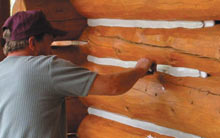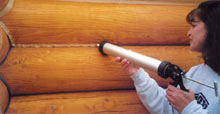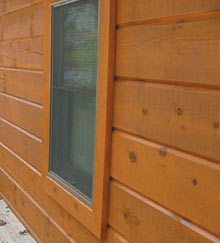Backing Material - Why You Need It
Backing materials are an integral part of a sealant system and should be used wherever possible. The overall performance of any sealant system is dependent on the use of correct application thickness and proper backing. For small joinery the most used backing is round backer rod. It comes in a range of sizes and is relatively inexpensive. It is flexible and can be pushed into a crevice without needing to be nailed or stapled.
In situations where joinery is too narrow to insert some type of backing material, a narrow strip of water resistant masking tape works well. (Avoid masking tape that wrinkles when wet because the wrinkles may show through the sealant after it has cured.) A good option is to use pinstripe tape available at most automotive supply stores. The tape should be water resistant, so Energy Seal does not adhere to it, making it a suitable backer material. Pinstripe tape is available in widths down to 1/8".
Approved Backing Materials
- Grip Strip
- Backer Rod
- Polyisocyanurate board (Polyiso or R Max)
- Expanded polystyrene (EPS) beadboard, foil-faced. Chinking applied over the foil covered side
- Water-resistant masking tape or pinstripe tape
DO NOT USE: Extruded Polystyrene (causes blisters), Polyurethane foam (Pur Fill, Great Stuff, Styrofoam), Blue Board, Pink Board or other colored board that outgases to cause blisters. If you are unsure about your backing material, check with Perma-Chink Systems before using it.
Tools
- Application bags, caulking gun or bulk loading caulking gun
- Follow plate for bulk loading gun
- Trowels and spatulas (close to the width of the finished seam is best)
- Rags and a bucket of water for general cleanup
- Spray/mist bottle (use water with a few drops of soap as a release agent)
- Masking tape if desired
PERMA-CHINK® - WHEN TO APPLY IT?
Download Log Home Sealants Application Guide PDF ![]()
Weather: Freshly applied sealants should be protected from direct rainfall for a minimum of 24 hours. Either watch the weather or drape a newly sealed wall with plastic film. Be sure to allow some airspace between the wall and the plastic to facilitate drying. Avoid applying sealants in direct sunlight or when the temperature is less than 40°F. In cold weather it's important that the logs be free of frost and dew in order to ensure that the sealant adheres tightly to the wood. Like stain, the best surface temperature range for easiest application and best results is between 50°F and 80°F.
- Best: after application of Lifeline™ stain, but before Lifeline Advance clear topcoat (Lifeline Advance should be applied over Perma-Chink log home sealant, making it easier to clean).
- Second Best: after application of Lifeline stain and Lifeline Advance topcoat.
- Worst: Over a fresh application of oil based stain. Oil based stains must be allowed to dry for 2 months. Then, clean the chinking surface with alcohol to remove dust and oily residues.
Application of Perma-Chink® Log Home Sealant
Before starting the application of Perma-Chink, inspect the installation of backing materials. Where pieces of backer butt up to one another, make sure that there are no gaps or ledges between pieces. If you find gaps, fill them with backing material or cover the span with tape. Make sure that the wood surfaces along the seam are clean and free of oils or waxes to insure proper adhesion of the cured chinking.
- Apply only as much chinking as you are able to tool smooth in about 15 minutes (less in warm dry weather that causes the chinking to skin over rapidly).
- Start by holding the applicator tip against the back surface of the joint and apply a bead of chinking. If multiple beads will be required to span the entire gap, apply them close together to avoid trapped air during tooling. Apply enough chinking to maintain a wet thickness of approximately 3/8 inch.

- The first step in finishing is to wet the trowel only (not the chinking), then spread it out evenly to 3/8 inch thickness, making sure the wet chinking is in good contact with the wood surfaces at both edges of the seam. Good contact is critical for proper adhesion after curing.
NOTE: Be careful to maintain proper thickness in all corners. After smoothing to the proper thickness, lightly wet the surface of the chinking and tool to finished smoothness. Avoid applying enough water to cause it to run onto the wood surface. Wipe any runs immediately.
Tip: If you used masking tape at the edges of the chinking, remove it now and smooth out edges with your tool. If your preference is for the finished chinking to have a different texture than smooth, you should experiment before application.
ROUND LOG CONSTRUCTION
When using Perma-Chink log home sealant on full-round log construction, the finished width of the chinking seam should be approximately 1/6 of the log diameter (i.e. if your logs are 15" diameter, the chinking seam should be about 2-1/2 inches wide.) This is very important on log home siding applications. Use proper width backing material to provide for your desired seam width when considering that the applied wet material will be approximately 3/8 inch thick.
SQUARE LOG CONSTRUCTION
Backing material and chinking seam width are determined by the engineered geometries of square log wall construction. It is always best to install backing materials so the finished chinking application does not result in a horizontal lip or ledge at the bottom edge of the seam where rainwater can accumulate. A little planning at this point can prevent a lot of maintenance in the future.
Drying/Curing
- Perma-Chink log home sealant develops a skin in a short period of time. Full curing requires it to dry all the way through and may take a number of weeks. Cool temperatures or high humidity extends drying time.
- Protect freshly applied sealants from rain for at least 24 hours to allow a protective skin to form.
- Blisters during curing are common to sealant applications in hot environments. Blisters can be caused by use of improper backing materials or by trapping air inside of the wet chinking during application. Prevent most blisters by making sure to trowel all air out of seams in "multi-bead" applications.
- Avoid application in direct sunlight on south and west walls. If newly applied chinking is exposed to sunlight and begins to blister, the effect can be minimized by shading the walls with white tarps for the first 1-2 days. In the first few days, blisters can be closed by puncturing the surface skin of the chinking and carefully pressing the blister surface back against the wet chinking inside.
ENERGY SEAL® and WOODSMAN™
 Energy Seal is a textured sealant that helps to match the appearance of the surrounding wood. The texture also allows it to accept a stain so that sealed joints and gaps become virtually invisible. Energy Seal may also be used in narrow chink joints with a width of one inch or less. Energy Seal can be used to seal gaps between logs, around windows, doors, vents and anywhere else where air or water can enter your home.
Energy Seal is a textured sealant that helps to match the appearance of the surrounding wood. The texture also allows it to accept a stain so that sealed joints and gaps become virtually invisible. Energy Seal may also be used in narrow chink joints with a width of one inch or less. Energy Seal can be used to seal gaps between logs, around windows, doors, vents and anywhere else where air or water can enter your home.
Woodsman multi-purpose sealant may be used for multiple applications in and around all types of homes. When used on the outside of a home this smooth surfaced sealant provides a flexible weather and water barrier that will not dry out and crack like most general purpose caulks.
Woodsman adheres to most common building surfaces such as wood, metal, concrete, brick, masonry, porcelain, ceramic tile, marble and glass. Ideal for sealing construction joints like window and door frames, woodwork, eaves, soffits, vents and expansion joints, Woodsman can also be used as an internal sealant between courses of logs.
When Should Energy Seal or Woodsman Be Applied?
Weather: Protect freshly applied sealants from rain until a water resistant skin has formed on new sealant application (usually about 24 hours). Avoid applying in direct sunlight to help prevent heat-induced blisters. Wood surface temperatures should be between 40°F and 90°F. Tarps can be used to protect sealant applications from weather.
Best: It is generally best to apply Energy Seal after walls have been cleaned and before stain is applied. Our sealants adhere aggressively to bare wood surfaces or to wood finished with Lifeline. For the least visible sealant lines, choose a sealant color that's a shade lighter than the stain you plan to use because it's easier to cover a lighter color sealant with a darker color stain than it is to hide a dark colored sealant with a light colored stain.
Or: if you want visible sealant lines, you may apply Energy Seal after you stain. If you do this, it is best to apply Lifeline Advance topcoat after the Energy Seal. This results in a more even appearance, helps them blend in with the rest of the wall and makes sealants easier to clean.
Worst: Application to surfaces with freshly applied oil-based stain should be avoided. The width of the backing material you require depends on the profile of your logs but be sure to take into account that you will be applying a 3/8" thick layer of sealant over it. Often, the sealant width is determined by the profile of milled logs and must be tailored accordingly.
SQUARE LOGS
Energy Seal or Woodsman is used on square log construction to seal corners, butt joints, windows, door frames and other areas where a visible chink joint is not desired. Also, for cosmetic chink joints (less than 3/8 inches deep) we recommend sealing the seam with Energy Seal and then applying Chink-Paint over the entire joint for the best completed appearance.
- Before starting, inspect the installation of all backing materials. Where individual pieces of backing join to one another, make sure there are no gaps, ledges or discontinuities that show through after the sealant has cured. Smooth, trim or bridge gaps with tape as necessary.
- To insure proper adhesion, make sure that wood surfaces where the sealant adheres are clean and free of oils, waxes or other contaminates.
Application
Cut the applicator tip to the desired diameter of the sealant bead you want to apply. Begin by holding the applicator tip firmly against the seam and apply a bead of sealant. Apply enough sealant to maintain a wet thickness of at least 5/16" and no more than ½" across the entire seam after tooling. Apply as much sealant as you can tool smooth in about 15 minutes to avoid a dried skin before final finishing.
After the joint is filled, trowel out to approximately 3/8th of an inch thick across the entire joint, making sure there is good contact between the sealant and the wood. Do not spray it with water at this time! Be careful to maintain proper thickness especially in corners!
Tip: Occasionally check the thickness of the sealant using a toothpick to see if you are maintaining the proper thickness. Once the sealant is roughly in place, spray it with a light mist of water and tool smooth with a trowel or spatula. Do not saturate the surface with water. If it begins to run you have applied too much.
Tip: If you used masking tape at the edges of the Energy Seal, remove it now and smooth out edges with your tool.
Clean-Up
If you get any sealant on the surface of the wood, be sure to wipe it off with a wet rag immediately. Dried sealant is very difficult to remove. Clean your tools and equipment with clean water occasionally during application.
Drying and Curing
Drying time and curing time are two entirely different terms. In warm or hot weather, Energy Seal and Woodsman may begin to skin over in as little as ten minutes while a complete cure may take a couple of weeks. Cooler temperature and high humidity slows the drying time and curing process.
CHECK MATE™ 2 - CHECK SEALANT
Check Mate 2 is an outstanding water resistant sealant that prevents water and air infiltration through pronounced cracks (called checks) in logs, timbers and wood siding. It is especially important to seal upward facing checks in any location where they may accumulate water. If these checks are left unsealed, they become sites where rot may begin to take hold. If you have old checks where rot is a risk, be sure to apply Shell-Guard before sealing with Check Mate 2.






Application
Like other flexible sealants, Check Mate 2 should be used in conjunction with Backer Rod whenever sealing a gap that's more than ¼ inch wide.
Make sure the Backer Rod is shoved into the check around 3/8- to ½-inch deep to allow room for the Check Mate 2.
Since Check Mate 2 comes in various colors, you should choose a color that is close to the color of the logs. However, if you are planning to stain over the Check Mate 2, choose a color that's a shade lighter than the stain. That way the Check Mate 2 will blend in with the surrounding stained wood. Remove masking tape while Check Mate 2 is still wet.
An 11 oz. Check Mate 2 tube will seal about 16 feet of 1/2-inch-wide checks.
Finished!
Call us @ 800-548-3554 | Order Samples or Product Online | Find A Contractor
1. Inspect | 2. Clean and restore | 3. Preserve | 4. Stain and Finish | 5. Chink and Seal
